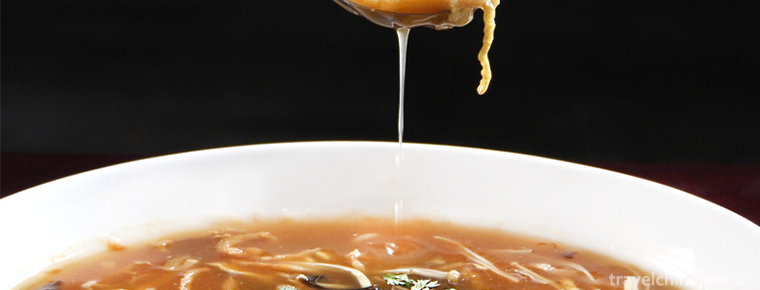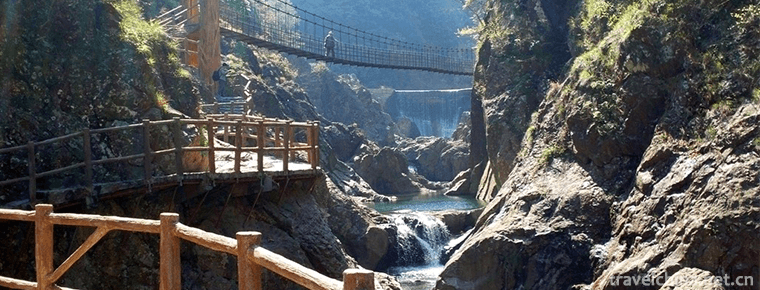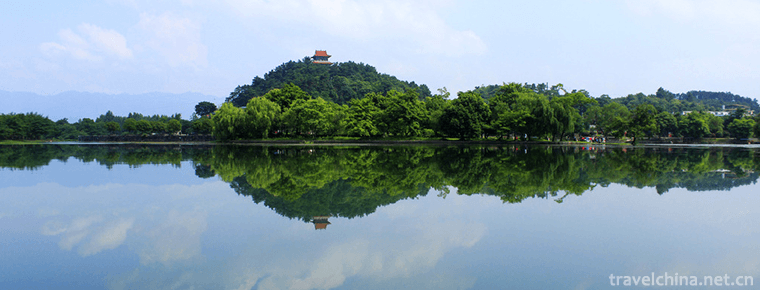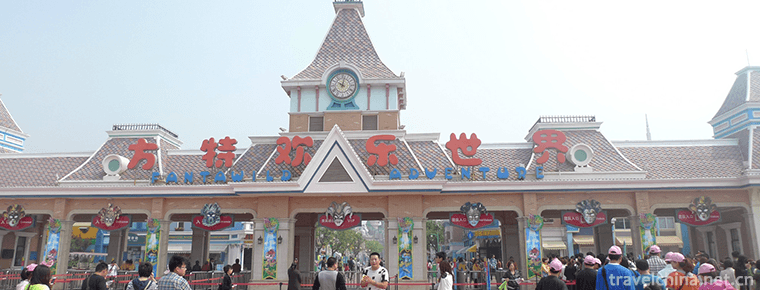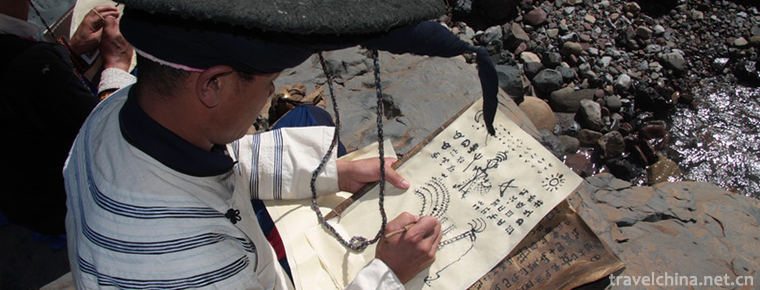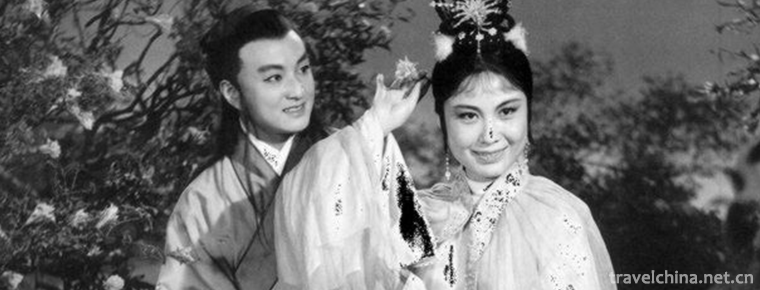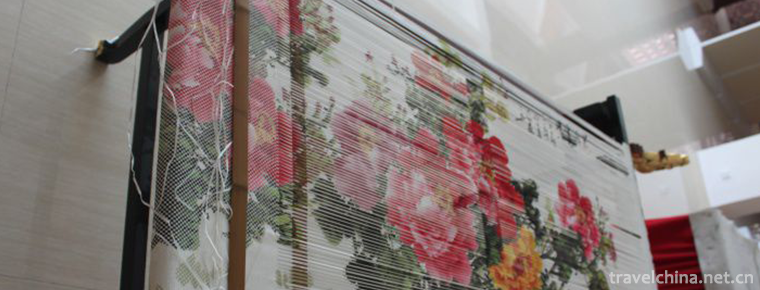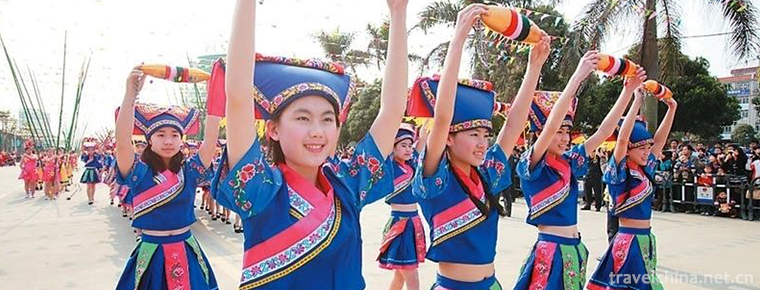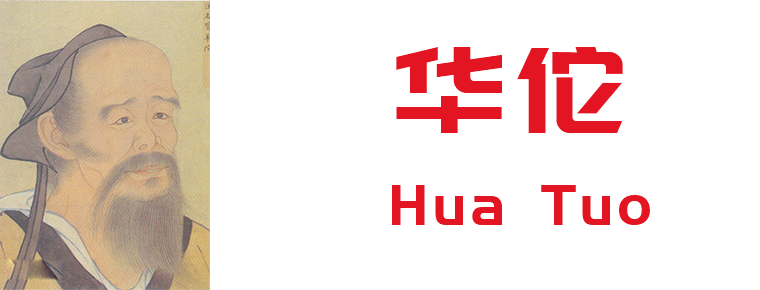Monkey Drum Encouragement of Yao Nationality
Monkey Drum Encouragement of Yao Nationality
"Monkey Drum Dance of Yao Nationality" is called "Jiuglang" in Yao language. It is popular among Baiku Yao people in Yaoshan. "Monkey Drum Encouragement" is performed in funeral and sacrificial occasions, constituting its specific dance form. Bai Kuyao worships ancestors very much, so his funeral is particularly exquisite. It mainly includes several procedures, such as washing the corpse into the coffin, chopping cattle to mourn, dancing Jiu Grang, drinking and carrying the coffin, setting the coffin in a shallow pit, dining at a long table and crossing the three dynasties. Dancing "monkey inspiration" is one of the most important activities.
On June 7, 2008, the Yao monkey drum was listed in the second batch of national intangible cultural heritage list with the approval of the State Council.
Historical Evolution
Once upon a time, there was an old Yao family named Bunu, who lived near the Pinghu River. His ancestors had helped Hou Ye for generations and suffered miserably. In Bunu's generation, Hou Ye and Wanhu Hou Ye across the river fought for territory. In order to win, Hou Ye needs all the helpers to go to the battlefield. If he doesn't go, he will be chopped by thousands of knives. When Bunu saw that Hou Ye was so vicious that he could no longer wait to die here, he secretly told his Yao brothers that thirty-six plans were the best.
After listening to Bunu's words, the Yao brothers gathered together one night and fled to the place where there were mountains.
Bunu took ordinary people away for a long time and was known by Hou Ye. He was so angry that he wanted to personally lead the troops to catch the escaped people back with thousands of knives. Because he was fighting with thousands of households and could not get away from them, he told the emperor that Bunu had brought ordinary people to fight against the South and asked the emperor to send troops to pursue and suppress them. At that time, the emperor was the sole guardian of his subordinates. Upon receiving the report from the Hou Ye, he immediately sent troops to the south to pursue the escaped Yao people. Royal soldiers will chase all the way, and many Yao people will be killed by them. Bunu, who was a scheming man, eluded the pursuit all the way, and led ordinary people into a mountain. The mountain is a hundred miles long and wide, with towering ancient trees and flocks of wild animals. There was a cave on the top of the hill. Bunu saw that it was a good place to hide. He led his compatriots into the cave and hid in it.
Bunu had not been hiding in the cave for three days before the Royal Army would catch up again. They were surrounded by four routes, from bottom to top, getting closer and closer to the cave. When Bunu saw the soldiers approaching, there was no way out. While he was sighing and waiting for his death, beside the rocks, a big monkey burst out, with a group of small monkeys, running in front of Bunu, dancing his plush arms, "squeaking and chirping" ceaselessly. Bunu didn't understand what the monkeys were talking about and ignored them. The monkey took Bunula to the rock gate. He looked down, and the imperial soldiers came straight to the cave, knowing that the situation was not good. When Bunu had no idea, he said to the monkey, "Brother monkey, if you have spirituality, please do me a favor and lead the royal soldiers away. Our Yao family will not forget you for generations."
As Bunu spoke, the big monkey gave a cry and took the monkeys to the rocks.
Soon after, only the sound of bells and drums and gongs came from the mountains opposite the forest. The noise was strong or weak, tinkling when sick, as if someone was celebrating something at the top of the ridge. At this time, the Royal pursued Yao soldiers, heard the sound of drums and gongs coming from the hilltop, thought it was Bunu who were celebrating the victory, and shouted: "Chase! They are playing drums and dancing on that hill!"
When Bunu heard the cry, he pulled the leaves out of the cave and looked at the top of the opposite hill. He saw a few monkeys knocking on the stalactites with stones on the rock wall, beating and jumping with joy. Royal soldiers, panting, climbed to the top of the hill to see a group of monkeys in the game, they were so angry that they could not catch Bunu, they had to catch monkeys to relieve hatred. They rushed up and the monkeys ran away. They stopped and the monkeys stopped and danced towards them. In this way, after chasing and stopping, the monkeys ran through several beams, and led the royal soldiers to the mountains full of insects and snakes. The Royal Soldier would never dare to flee again, so he had to retire and return to the DPRK.
After the monkey led the Royal pursuers away, Bunu and his Yao brothers settled down in the mountains. As they fight against wild animals and cultivate wasteland, they live quietly in isolation from the rest of the world. Later, Bunu remembered that the Yao family could live on this high mountain without being killed by the Royal generals who had come after them. It was all helped by the spiritual monkeys. In order to repay the monkey's kindness, every spring, Bunu chose a day to lead the Yao brothers, prepare three sacrifices of wine, burn incense and offer sacrifices, and call on everyone to beat drums, gongs, monkey masks, learn the monkey's movements, and dance monkey drums to inspire and beat monkey drums happily.
In memory of the migration of the ancestors and the escort of the monkeys, the Yao people imitated the scenes of their ancestors climbing mountains and wading waters, and the dance of the monkeys climbing and jumping. Over time, the dance of sacrificing ancestors and commemorating the monkeys evolved into an important ceremony in the funeral and sacrifice activities of the Yao people. It is a folk sacrificial dance for the ancestors of the Baikuyao nationality, which only spreads in the Baikuyao area of Yaoshan Yao nationality township in Libo County.
Stylistic features
Basic movements
"Monkey Drum Dance" mainly consists of three parts: single dancing, double dancing and group dancing. They are to open the road, walk and send the elderly. It is characterized by drum beating by wooden drummers, and its dancing posture is characterized by buckling chest, bending knees, crouching, steadfastness and beating drums back and forth, accompanied by imitating monkeys'various postures and expressions. Its movements include "three beats on drum face", "lotus flower", "back" and "foot piercing". Its dancing movements are soft and rigid, rough and simple, with light and heavy points. Ming Dynasty, strong sense of rhythm, jumping posture lively and unique charm.
When dancing, people gathered in a big circle, with leather drums standing in the circle, and several or more copper drums suspended on the other side. There are two musicians on each side of the drum, one beats the drum, and one holds the "resonance box" like a steamer behind the drum. Like water, the drum goes in and out behind the drum, so as to make the sound of the drum more often deep, thick and pleasant. In the sound of bronze drums, the drummer beats and dances around the drum. The drummer is the leader and conductor. He hit the drum face and body. People danced one after another with drums, imitating monkeys'various postures and movements, climbing, climbing, jumping, jumping, dancing in a soft, rigid, light and heavy manner, fully reflecting the heroic image of the Yao people.
When playing, the drum is usually placed on the drum stand. The player stands beside the drum and plays with both hands. It can also be hung around the neck by a drum tie, and danced while hitting the belly. One can carry a drum and the other can dance while hitting. The timbre is rugged. It is mainly used for accompaniment of the Yao folk dance Monkey Drum Dance. The dancers are usually twelve, no matter how many. The performers disguised themselves as monkeys, beating monkey drums, gongs, cymbals, or holding golden hoops, banana fans and other props, simulating monkeys'jumping, scratching, playing and other movements, dancing, the beginning of the whole dance, speed, are also based on the rhythm of monkey drums.
On the Danu Festival of the Yao nationality, people collectively perform "Monkey Drum Encouragement". The high drums and vigorous dances add a warm atmosphere to the festival. For days in a row, all night long, to the best of the party scattered.
Prop
Yao Monkey Drum and Yao Membrane Singing Instrument. It was named for its accompaniment to Monkey Drum Encouragement. It is prevalent in the Yao nationality area of Shanglin County in the central part of Guangxi Zhuang Autonomous Region.
Legend has it that every Danu Festival (also known as Yao Year or Zuniang Day) of the Yao nationality, the Yao people of the Bunu tribe hold three grand national festivals from May 27 to 29 of the lunar calendar to commemorate the great victory of their ancestors in resisting the feudal dynasty. At that time, Yao people, men, women and children, dressed in costumes, gathered in drum halls from all sides for celebrations. The gongs and drums are noisy, people sing and dance, performing folk dances such as monkey drum, bronze drum, Lusheng dance, horn dance, etc. The dancers dance while playing, the atmosphere is very warm, reflecting the struggle and production activities of Yao ancestors.
The drum frame is made of the whole section of camphor wood hollow, which is round and pier-shaped. The drum mouth is 25 cm in diameter and 35 cm in height at both ends. The drum waist is slightly larger than the waist diameter. The two ends are covered with goat skin. The skin surface is larger than the drum mouth 20 cm. There are several small holes drilled around the edge. Small sticks are pierced between each two holes. The small sticks corresponding to the drum skin are roped to each other. Back tightening, the middle of the rope is tightened with a small wooden rod, and then into the wood wedge, the drum skin can be tightened. Guchu wood, straight rod-shaped, 30 cm long.
Current situation of inheritance
The inheritance of "monkey drum" still maintains the form of family oral teaching, with unique national characteristics and ancient heritage. With the rapid development of economy and society, the daily changes of people's lives in urban and rural areas, the infiltration of various foreign cultures, and the migration of young Yao men and women to work, there are few folk inheritors. In addition, "monkey drum dance" is a kind of sacrificial dance formed by folk spontaneous organizations, which faces the threat of assimilation, alienation, loss and extinction. Its inheritance of skills is endangered and endangered.
Inheritance Significance
The whole dance style is simple and rugged, enthusiastic and fierce, and there are many vigorous and agile jumping and running scenes, which fully reflects the original national character of the Yao people.

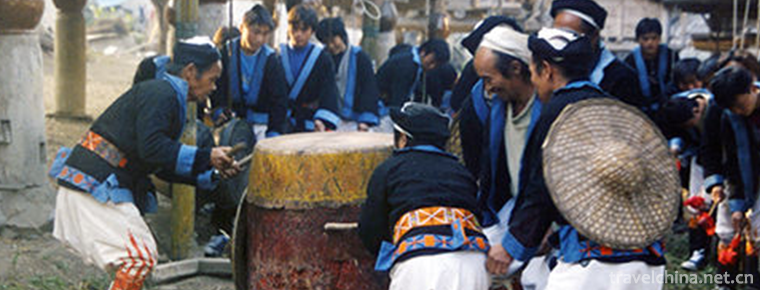
-
Free and unfettered hu hot soup
The authentic Xiaoyao Town Hu Hot Soup, produced in Xiaoyao Town, Xihua County, Zhoukou City, Henan Province, is a famous snack in China.
Views: 277 Time 2018-11-26 -
Caoxi Hot Spring Holiday Resort
Caoxi Hot Spring Holiday Resort is located in Qujiang Maba, Shaoguan City. It is the largest hot spring villa resort in Guangdong Province. It is located on 106 National Highway under the outlet of Sh.
Views: 334 Time 2019-01-04 -
Linqu canal
Lingqu, formerly known as the Qin Digging Canal, Zero Canal, Douhe Canal, Xing'an Canal and Xianggui Canal, is a great project created by the working people of ancient China.
Views: 328 Time 2019-01-30 -
Mount Tai Fonters Happy World
Tai'an Fangte Happy World is located in the eastern New Area of Taishan District, Tai'an City, Shandong Province. Font's Happy World is characterized by science fiction and animation.
Views: 367 Time 2019-02-13 -
Bemo painting
Bimo Painting of the Yi Nationality is a kind of picture on paper or animal skin, bark, bamboo slips, stone, wooden boards and other carriers painted by Bimo, a priest of the Yi Nationality..
Views: 245 Time 2019-04-04 -
Legend of Cowherd and Weaver Girl
Niulang and Zhinu are one of the four Chinese folk love legends (the other three are Legends of White Snake, Meng Jiangnu Crying Great Wall, Liang Shanbo and Zhu Yingtai). They derive from the star na.
Views: 310 Time 2019-06-08 -
Xujiaquan
Xujiaquan, a traditional boxing method, originated in Tongji Village, Xintai City, Shandong Province. Xujiaquan originated in Yongzheng Period of Qing Dynasty and was created by Xu Shengcai, Gaozu of .
Views: 168 Time 2019-07-09 -
Yongchun Paper Weaving Painting
"Yongchun County Chronicle" records: "In the early Tang Dynasty, Yongchun had the production of paper-woven paintings. Yongchun paper weaving painting features: interwoven paper marks, .
Views: 170 Time 2019-07-14 -
Song pool of the Zhuang nationality
Song pool of the Zhuang nationality is a form of Festival gathering and singing activities held by the masses of the Zhuang nationality at a specific time and place..
Views: 298 Time 2019-08-16 -
Hua Tuo
Hua Tuo (about 145 ad - 208 AD), the character is changed into one. Pei country Qiao County People, Eastern Han Dynasty The famous medical scientist at the end of the year..
Views: 217 Time 2019-09-07 -
Panzhihua from the Ming Dynasty to the Republic of China
In 1382, in the 15th year of Hongwu reign of the Ming Dynasty, the Xuanwei Department of paloros put Yunnan under the jurisdiction of Sichuan Chengxuan political envoys. In this place, there is another commander's Department of Sichuan Xingdu, which leads the lawsuits.
Views: 88 Time 2020-12-14 -
medical and health work
By the end of 2019, there are 2139 medical and health institutions with 19943 beds. At the end of the year, there were 14351 technical personnel in hospitals and health centers, including 4839 licensed doctors and 6767 registered nurses. The numbe.
Views: 346 Time 2020-12-18
